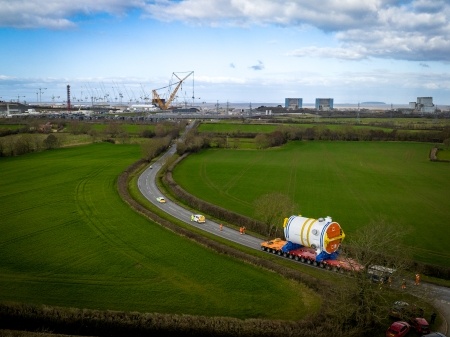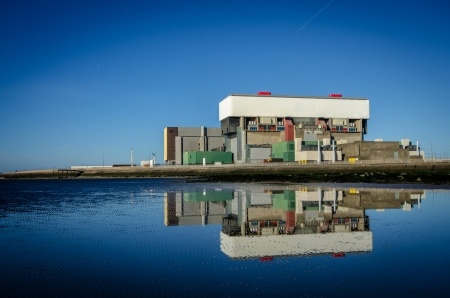
EDF UK R&D Net Zero Heroes: Ehimen Iyamabo
Climate change is one of the most significant challenges we face but we can all make a difference. In the summer of 2020, EDF launched its company purpose ‘Helping Britain achieve Net Zero’ and CEO Simone Rossi set out how all employees can play their part.
We recognise that the work we do makes us all Net Zero Heroes and this is particularly true in R&D.
For this portrait, we are hearing from Ehimen Iyamabo – Research Engineer of the Advanced Reactors and Structural Integrity/Nuclear team based at The University of Manchester. Ehimen is the lead of the computational fluid dynamics (CFD) unit of the team which works closely with Nuclear Generation to tackle complex problems of EDF UK’s current nuclear fleet and generate innovative solutions for future advanced reactors.
How long have you worked at EDF, and how long in R&D?
I joined the Modelling and Simulation Centre (MaSC) at EDF R&D, now known as the Advanced Reactor and Structural Integrity team, in February 2020. Before joining EDF UK R&D, I was completing my PhD at The University of Manchester, where my office was a few metres away from MaSC. Also, my PhD was supervised by Professor Dominique Laurence, who had concurrently worked for EDF R&D Group.
Hence, I had engagements with the research experts at EDF R&D prior to joining the company (with the occasional invitations of EDF staff to the PhD coffee mornings and events), and these engagements opened my mind to impactful activities happening at MaSC in support of the EDF nuclear fleet and the company Net Zero commitments. This inspired me to want to be part of a group that has been making a difference in producing low-carbon energy.
What is your role within EDF UK R&D and how does it help Britain achieve Net Zero?
My primary responsibility is being the Computational Fluid Dynamics (CFD) lead of the team which executes the strategic R&D priorities of the nuclear programme of EDF UK. I provide technical support to the thermal-hydraulics activities of the Advanced Gas-cooled Reactors (AGRs). As the AGR programme is safely landing, I develop numerical tools that assist end users at Nuclear Generation in making risk assessments of critical components of the reactors. These models also help engineers to make lifetime extension decisions, for example it helped with the recent decision to extend the life of Heysham 1 and Hartlepool AGR reactors for another two years to 2026, saving 10 million tonnes of CO2 emissions.
Furthermore, my activities extend to Light Water Reactor (LWR) technology, including Sizewell B and Hinkley Point C. I am involved in investigating the power fluctuation observed in an EPR plant and collaborating with Nuclear Generation to develop strategies to mitigate this problem at Hinkley Point C. Our team is a partner of the GOVIKING project, funded by the European Commission – Horizon Euratom, where we investigate the influence of flow-induced vibration on the structural integrity of fuel rods and steam generators in Pressurised Water Reactors (PWRs). The findings of these projects will support engineers in the safe and efficient operation of Hinkley Point C when it comes online, Sizewell B and other future EPR plants.
Finally, I participate in the Net-Zero Development programme which is looking into leveraging our skills acquired in the running of AGR/PWR operations to develop and deploy emerging advanced nuclear technologies, in particular High Temperature Gas Reactors (HTGRs) and fusion. Our team is currently exploring the use of thermalhydraulic calculations to verify the safety claims made by Advanced Modular Reactor (AMR) vendors particularly on the effectiveness of natural convection passively removing heat from the reactor core during loss of forced-cooling incidents. We also engage with various stakeholders across the government, universities, and EDF Group to address UK-specific technology/regulatory challenges and create innovative solutions for the future deployment of advanced reactor technologies.
What do you like best about working in EDF UK R&D?
There is great warmth and passion among the people working in EDF UK R&D. These attributes make me feel relaxed and drive me in wanting to make an impact in the company. EDF UK R&D is uniquely positioned where one can easily interact with various stakeholders within the wider EDF group and leverage their expertise to generate pioneering solutions. Our work has a direct impact on the safe and efficient running of the EDF nuclear fleet. This makes one feel that they are making a significant difference in producing lowcarbon energy and helping the UK to achieve its Net-Zero commitments.
What’s your favourite of the projects you’ve worked on in the last year?
My favourite project in the past year is the development of a numerical model to assess the thermal-hydraulic parameters of the serpentine boilers found in Heysham 2 and Torness power plants. The ageing of the AGR nuclear plants presents a significant safety challenge that requires effective management to achieve EDF’s lifetime ambitions. The boilers have been identified as a potential performance risk and lifetime limiting component. Measurements in the serpentine boilers are limited due to the difficulty of accessing the boilers and the complexity of geometry. Hence, I commenced developing a computational model to predict complex thermal-hydrodynamic variables in the boilers to assist engineers in making riskassessment.
I have been the lead developer of this project in the design and build of the numerical model. The model has coupled tools developed by EDF teams in both France and the UK to represent the thermal-flow phenomena in the boiler. I have worked closely with the thermal-hydraulic experts at Nuclear Services to ensure that the numerical model meets all the key specifications of the serpentine boilers.
The development of this project is ongoing, and we have commenced validating the numerical model with early-life plant data from Heysham 2 and Torness plants. Over the ~35 years of operation, the boilers have been affected by carbon deposition on the tubes, tube plugging, thermal load balance issues and other phenomena that have led to the boiler operating differently from the original design. The next stage of the project will be testing the serpentine boiler model to accurately predict the performance of the boiler affected by these late-life phenomena.
Related articles

EDF UK R&D Net Zero Heroes: Ruth

Exciting progress on hydrogen plans for Heysham 2
